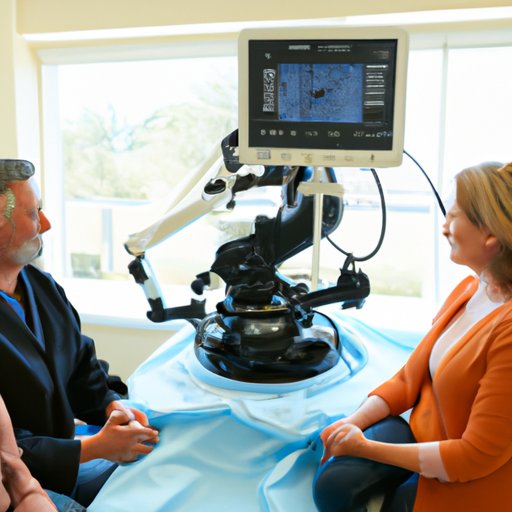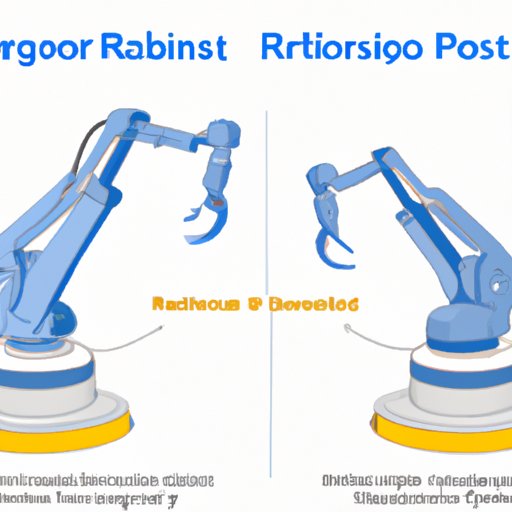Introduction
A robotic hysterectomy is a minimally invasive surgical procedure that removes all or part of the uterus. The procedure is usually performed to treat uterine fibroids, endometriosis, uterine cancer, or other gynecological conditions. Robotic hysterectomy can be performed in both inpatient and outpatient settings. This article will explore the advantages of a robotic hysterectomy as an outpatient procedure.

Examining the Advantages of a Robotic Hysterectomy for Women in an Outpatient Setting
Robotic hysterectomy offers many benefits for women who undergo the procedure in an outpatient setting. These benefits include a shorter recovery time, less pain and discomfort, and a lower risk of complications.
Shorter Recovery Time
Robotic hysterectomy allows for a much shorter recovery time than traditional open surgery. The minimally invasive nature of the procedure means that it can be completed in less time than traditional hysterectomy. This is especially beneficial for women who are seeking to return to their daily activities quickly.
Less Pain and Discomfort
The minimally invasive nature of a robotic hysterectomy also means that patients experience less pain and discomfort after the procedure. This is due to the fact that the incisions used during the procedure are smaller than those used in traditional surgery. Additionally, the robot-assisted technology allows for more precise movements during the procedure, which helps reduce tissue trauma and minimize post-operative pain.
Lower Risk of Complications
Robotic hysterectomy has a lower risk of complications than traditional surgery due to the precision of the robot-assisted technology. This technology allows the surgeon to make smaller, more controlled incisions and movements, reducing the risk of unnecessary tissue damage. Additionally, the shorter recovery time associated with a robotic hysterectomy also reduces the risk of post-operative complications.

Comparing the Traditional and Robotic Hysterectomy: Outpatient vs. Inpatient Procedures
When comparing traditional and robotic hysterectomies, there are several differences between the two types of procedures. These differences can be seen when examining the duration of the surgery and the post-operative care required.
Differences in Surgery Duration
Robotic hysterectomy typically takes less time than traditional open surgery. This is due to the fact that the robot-assisted technology allows for more precise movements and incisions. Additionally, the shorter recovery time associated with a robotic hysterectomy means that the procedure can often be completed in one day.
Differences in Post-Operative Care
The type of post-operative care required after a robotic hysterectomy is typically less intensive than that required after a traditional hysterectomy. This is due to the fact that the incisions used in a robotic hysterectomy are much smaller and require less healing time. Additionally, the shorter recovery time associated with a robotic hysterectomy means that the patient can often return home the same day.
Understanding the Process and Benefits of a Robotic Hysterectomy as an Outpatient Procedure
Robotic hysterectomy is a relatively simple procedure that can provide many benefits for women in an outpatient setting. The following sections will discuss the pre-operative preparation, surgical procedure, and post-operative care associated with a robotic hysterectomy.
Pre-Operative Preparation
Prior to the procedure, the patient will need to have a physical examination and blood work done. Additionally, the patient should discuss any medications they are taking with their doctor, as some medications may need to be discontinued prior to the procedure. Finally, the patient should also discuss any allergies they may have with their doctor, as these may affect the type of anesthesia used during the procedure.
Surgical Procedure
During the procedure, the surgeon will make small incisions in the abdomen. A camera is then inserted through one of the incisions, allowing the surgeon to view the uterus on a monitor. The robot-assisted technology is then used to make precise movements and incisions, allowing for a minimally invasive procedure. Once the uterus has been removed, the incisions are closed and the patient is taken to the recovery room.
Post-Operative Care
After the procedure, the patient will be monitored in the recovery room. Depending on the type of procedure performed, the patient may need to stay overnight or be discharged the same day. After discharge, the patient will need to rest and follow any instructions given by their doctor. They should also avoid strenuous activities and heavy lifting for at least two weeks after the procedure.

Analyzing the Cost Savings of Performing a Robotic Hysterectomy as an Outpatient Procedure
One of the major benefits of performing a robotic hysterectomy as an outpatient procedure is the cost savings associated with it. When compared to traditional inpatient procedures, robotic hysterectomies can save patients thousands of dollars in hospital costs.
Cost Comparisons between Inpatient and Outpatient Procedures
The average cost of a traditional inpatient hysterectomy is around $10,000. On the other hand, the average cost of an outpatient robotic hysterectomy is around $8,000. This difference in cost can be attributed to the fact that outpatient procedures require fewer resources and staff, resulting in lower hospital costs. Additionally, since the recovery time is shorter with a robotic hysterectomy, there is no need for an extended hospital stay.
Insurance Coverage for Robotic Hysterectomies
Most insurance companies cover robotic hysterectomies as an outpatient procedure. However, it is important to check with your insurance provider to ensure that the procedure is covered by your policy. Additionally, depending on your insurance coverage, you may be responsible for a portion of the cost of the procedure.
Conclusion
A robotic hysterectomy is a minimally invasive procedure that can provide many benefits for women in an outpatient setting. These benefits include a shorter recovery time, less pain and discomfort, and a lower risk of complications. Additionally, there are significant cost savings associated with performing a robotic hysterectomy as an outpatient procedure. Ultimately, it is up to the patient to decide if a robotic hysterectomy as an outpatient procedure is right for them.
Summary of Benefits of an Outpatient Robotic Hysterectomy
Outpatient robotic hysterectomies offer many benefits for women, including a shorter recovery time, less pain and discomfort, lower risk of complications, and cost savings. Additionally, pre-operative preparation, surgical procedure, and post-operative care are all relatively straightforward processes.
Final Thoughts on Choosing an Outpatient Robotic Hysterectomy
Robotic hysterectomy is a safe and effective procedure that can provide many benefits for women in an outpatient setting. Before making a decision, it is important to discuss the risks and benefits of the procedure with your doctor. Additionally, it is important to check with your insurance company to ensure that the procedure is covered by your policy.
(Note: Is this article not meeting your expectations? Do you have knowledge or insights to share? Unlock new opportunities and expand your reach by joining our authors team. Click Registration to join us and share your expertise with our readers.)
